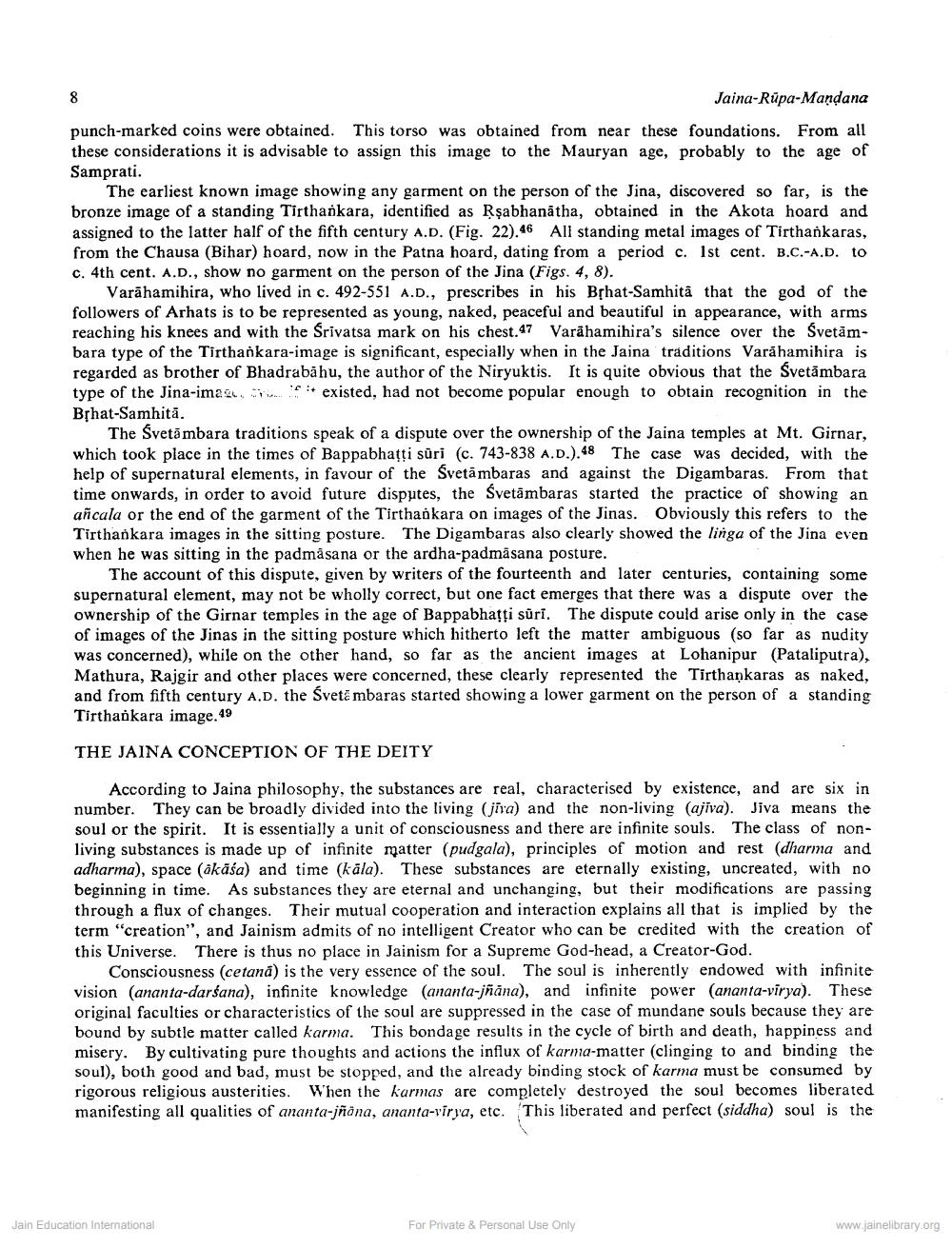________________
Jaina-Rupa-Mandana punch-marked coins were obtained. This torso was obtained from near these foundations. From all these considerations it is advisable to assign this image to the Mauryan age, probably to the age of Samprati.
The earliest known image showing any garment on the person of the Jina, discovered so far, is the bronze image of a standing Tirthaókara, identified as Rşabhanatha, obtained in the Akota hoard and assigned to the latter half of the fifth century A.D. (Fig. 22).46 All standing metal images of Tirthankaras. from the Chausa (Bihar) hoard, now in the Patna hoard, dating from a period c. 1st cent. B.C.-A.D. to c. 4th cent. A.D., show no garment on the person of the Jina (Figs. 4, 8).
Varāhamihira, who lived in c. 492-551 A.D., prescribes in his BỊhat-Samhita that the god of the followers of Arhats is to be represented as young, naked, peaceful and beautiful in appearance, with arms reaching his knees and with the Srivatsa mark on his chest.47 Varahamihira's silence over the Svetāmbara type of the Tirthaikara-image is significant, especially when in the Jaina traditions Varā hamihira is regarded as brother of Bhadrabahu, the author of the Niryuktis. It is quite obvious that the Svetāmbara type of the Jina-imagu. . + existed, had not become popular enough to obtain recognition in the Bphat-Samhita.
The Svetā mbara traditions speak of a dispute over the ownership of the Jaina temples at Mt. Girnar, which took place in the times of Bappabhatti sūri (c. 743-838 A.D.).48 The case was decided, with the help of supernatural elements, in favour of the Svetāmbaras and against the Digambaras. From that time onwards, in order to avoid future disputes, the Svetāmbaras started the practice of showing an añcala or the end of the garment of the Tirthaókara on images of the Jinas. Obviously this refers to the Tirthankara images in the sitting posture. The Digambaras also clearly showed the linga of the Jina even when he was sitting in the padmāsana or the ardha-padmāsana posture.
The account of this dispute, given by writers of the fourteenth and later centuries, containing some supernatural element, may not be wholly correct, but one fact emerges that there was a dispute over the ownership of the Girnar temples in the age of Bappabhatti suri. The dispute could arise only in the case of images of the Jinas in the sitting posture which hitherto left the matter ambiguous (so far as nudity was concerned), while on the other hand, so far as the ancient images at Lohanipur (Pataliputra), Mathura, Rajgir and other places were concerned, these clearly represented the Tirthankaras as naked, and from fifth century A.D. the Svetë mbaras started showing a lower garment on the person of a standing Tirthaikara image. 49
THE JAINA CONCEPTION OF THE DEITY
According to Jaina philosophy, the substances are real, characterised by existence, and are six in number. They can be broadly divided into the living (jira) and the non-living (ajiva). Jiva means the soul or the spirit. It is essentially a unit of consciousness and there are infinite souls. The class of nonliving substances is made up of infinite matter (pudgala), principles of motion and rest (dharma and adharma), space (akāśa) and time (kāla). These substances are eternally existing, uncreated, with no beginning in time. As substances they are eternal and unchanging, but their modifications are passing through a flux of changes. Their mutual cooperation and interaction explains all that is implied by the term "creation", and Jainism admits of no intelligent Creator who can be credited with the creation of this Universe. There is thus no place in Jainism for a Supreme God-head, a Creator-God.
Consciousness (cetana) is the very essence of the soul. The soul is inherently endowed with infinite vision (ananta-darśana), infinite knowledge (ananta-jñana), and infinite power (ananta-virya). These original faculties or characteristics of the soul are suppressed in the case of mundane souls because they are bound by subtle matter called karma. This bondage results in the cycle of birth and death, happiness and misery. By cultivating pure thoughts and actions the influx of karma-matter (clinging to and binding the soul), both good and bad, must be stopped, and the already binding stock of karma must be consumed by rigorous religious austerities. When the karmas are completely destroyed the soul becomes liberated manifesting all qualities of ananta-jñana, ananta-virra, etc. This liberated and perfect siddha) soul is the
Jain Education International
For Private & Personal Use Only
www.jainelibrary.org




